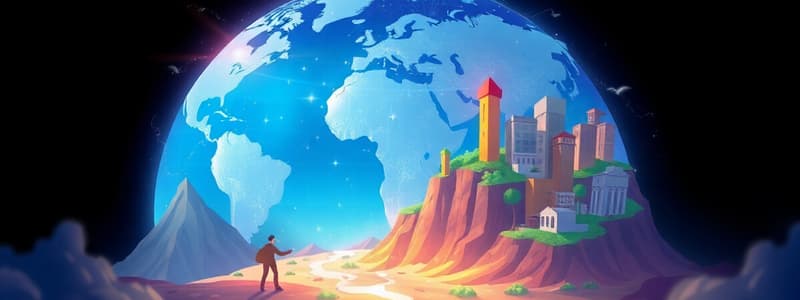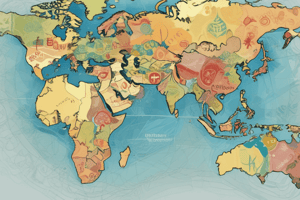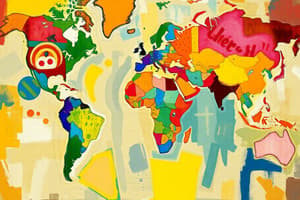Podcast
Questions and Answers
Which factor most significantly contributes to India's population growth?
Which factor most significantly contributes to India's population growth?
- A consistently high birth rate over the past decades.
- A demographic transition characterized by a decreasing mortality rate while the birth rate remains relatively high. (correct)
- A steady increase in immigration rates.
- Government policies encouraging larger families.
What is the primary economic idea supported by Nobel laureates regarding development, as applied to India's context?
What is the primary economic idea supported by Nobel laureates regarding development, as applied to India's context?
- Guaranteeing property rights to foster investment and wealth creation. (correct)
- Heavy state intervention in key economic sectors.
- Implementing strict protectionist trade policies.
- Focusing exclusively on developing heavy industry.
Which of the following most accurately describes the trend in India's sex ratio?
Which of the following most accurately describes the trend in India's sex ratio?
- A balanced ratio due to stringent enforcement of gender equality laws.
- A surplus of females due to cultural preferences.
- A deficit of females, exacerbated by illegal abortions favoring males. (correct)
- An improving ratio primarily due to declining female infanticide rates.
What is a significant challenge associated with India's economic growth?
What is a significant challenge associated with India's economic growth?
How does India's energy mix contribute to its environmental challenges?
How does India's energy mix contribute to its environmental challenges?
What was a controversial demographic policy implemented in India in 1975?
What was a controversial demographic policy implemented in India in 1975?
Which of the following best captures the essence of the "Make in India" initiative?
Which of the following best captures the essence of the "Make in India" initiative?
What geopolitical strategy does India employ to balance its relationships with major world powers?
What geopolitical strategy does India employ to balance its relationships with major world powers?
What is a significant drawback to India's reliance on coal as an energy source?
What is a significant drawback to India's reliance on coal as an energy source?
Which of the following factors contributes most significantly to income inequality in India?
Which of the following factors contributes most significantly to income inequality in India?
How does the concentration of wealth among the richest Indians compare to that of the richest people in France?
How does the concentration of wealth among the richest Indians compare to that of the richest people in France?
What is a major demographic challenge China is currently facing?
What is a major demographic challenge China is currently facing?
Why did China recently relax its one-child policy?
Why did China recently relax its one-child policy?
Which factor primarily determines whether a country benefits from its demographic transition?
Which factor primarily determines whether a country benefits from its demographic transition?
What characterizes Niger's demographic profile?
What characterizes Niger's demographic profile?
Flashcards
Geography
Geography
Science studying how human societies arrange and transform their spaces.
Globalization
Globalization
Process of increasing and liberalizing exchanges on a global scale.
Demographic Transition
Demographic Transition
Phase transition from high birth and death rates to low ones.
Overpopulation
Overpopulation
Signup and view all the flashcards
Family Planning
Family Planning
Signup and view all the flashcards
Sterilization in India
Sterilization in India
Signup and view all the flashcards
Demographic Dividend
Demographic Dividend
Signup and view all the flashcards
Morocco
Morocco
Signup and view all the flashcards
Fertility Rate
Fertility Rate
Signup and view all the flashcards
Mix of Energy
Mix of Energy
Signup and view all the flashcards
Greenhouse Gas Emission Rise
Greenhouse Gas Emission Rise
Signup and view all the flashcards
Richest Rank
Richest Rank
Signup and view all the flashcards
Study Notes
- Geography studies how human societies organize and transform spaces
Globalization
- Globalization is the process of intensifying and liberalizing exchanges on a planetary scale
- This phenomenon began in 1970-1980, aided by factors like the internet, containers, and the end of the Cold War
Developed vs. Non-Developed Countries
- F. Lenglet distinguishes between developed and non-developed countries
- Some countries take "false routes," while others discover the keys to development
- False keys include climate, sociocultural factors (religious mentalities), and politics (democracy, if favorable)
- Nobel economists believe development hinges on guaranteeing property rights and the need to work to earn money and rise in society
Case Study: India - Challenges
- India faces demographic, social, environmental, and policy-related challenges
Demographic Challenges
- India's population has grown by about 50% every 20 years since 1940
- Population figures:
- 1960: 500 million
- 1980: 750 million
- 2000: 1 billion
- 2025: 1.4 billion
- Birth rates are declining due to progress, but still stagnate
- The number of children per woman remains the same, but infant mortality decreases
- Later family awareness and decreased wealth due to inheritance division among more children are noted
- Rural exodus causes housing difficulties
- Increased education among women leads to different life aspirations compared to their mothers and grandmothers
- Population growth is significantly influenced by demographic transition
Demographic Transition
- Demographic transition involves a shift from a "pre-transitional" demographic regime (high birth and death rates, low natural increase) to a "post-transitional" regime (low birth and death rates, low natural increase)
- During the transition phase, mortality rates decrease
- India's demographic transition started in the 1920s, with phase 2 beginning in 1970
- By 1970, India faced a birth rate peak
- The ideal fertility rate is 2.05
- Fertility rate in India
- 1970: 6
- 2000: 3
- 2023: 2.01
- There is a shortage of 63 million women in India
- The natural sex ratio is 100 girls per 105 boys for every 100 girls. In India, it is 930 girls per 1000 boys
- This is due to illegal abortions because Indian families often prefer sons, and daughters may receive less attention and care
- There is an Indian saying: "Raising a daughter is like watering your neighbor's garden," referencing the dowry system
Social and Environmental Challenges
- India's socio-economic challenge includes a 7% annual growth rate, but growth is very unequal, increasing inequalities
- India ranks as the 5th richest power in the world
- It lies at 122nd out of 150 countries in GDP per capita
- France is the 7th world power, and 25th in GDP per capita
- The literacy rate is 77% (70% for women, 85% for men), compared to 17% at independence in 1947
Environmental Factors
- India's environmental challenge: significant pollution
- Energy mix: 55% coal, 30% oil, 8% natural gas
- 70% of electric production depends on coal
- Greenhouse gas emissions, comparing 1990 to 2018:
- India: x3 increase
- World: +67% increase
- India is the 2nd largest coal producer, with 10% + 15% of the world's coal reserves, and the 2nd largest importer
- Coal is used as fuel in thermal power plants, providing cheap energy
Policies for development in India
- There are demographic and environmental aspects of development
Demographic limits
- Female sterilization was forced under the state of emergency in 1975, and it is now legal
- Sterilization rates
- 37.9% in 2022
- 36% in 2016
- Populations are traumatized by forced sterilization: 1/3 of married women, or 180 million
Environmental limits
- Reliance on cheap coal causes environmental costs and significant pollution, and smog
- The level of water tables is diminishing
Social limits
- India's development strategy has increased inequality, including access to services
- India had the largest number of people living below the extreme poverty line: 70 million people, which is now the 2nd lowest income country by average
- The majority of India's wealth is held by a minority of the population
-1% of the richest population in have 40% of the country's 66% heritage
- 50% of the poorest people have 6% of the heritage
- In comparison, the richest 1% in France hold 15% of the heritage
- The poorest populations live in slums
- Dharavi, near Mumbai, with 600,000 inhabitants
- Oranji Town, near Karachi, Pakistan, with 1.5 million inhabitants
- The unemployment rate in India is 8%, but women are discouraged from working: only 20% of women work
- The Indian economy offers few jobs, and millions of qualified individuals cannot find employment
China's Demographic Challenges
- 1976: unexpected recovery of birth rates
- 1979: one-child policy was adopted
- Families with more than one child faced heavy penalties -Imposed taxes -Difficulty finding jobs -Difficulty finding places Result: The birth rate continued to decline
- The aging of the population increased
- 2005: The aging of the Chinese population was observed with the share of over 65s increasing
- The income in China has risen, and the birth rates have dropped
Demography in China
- 2010s: Chinese officials tried to rectify the birth rate
- 2013: the policy of the unique child was relaxed to allow couples with a single child to have a second
- 2016: officials ended the policy of the unique child
- 2021: China permitted three children
- It was anticipated that the workforce would weaken the country
- One strategy to avoid this was to raise taxes
- Another strategy was to push back the age of retirement to 64 for men and around 50 for women
Global Population Trends
- A strong, slowing demographic increase
- Population bomb defused
- Overpopulation is relative
- There is a relationship between a population, resources (food, housing, etc.)
Population Figures
- 0 AD: 250 million
- 1800: 1 billion
- 1950: 2.5 billion
- 1987: 5 billion
- 1999: 6 billion
- Every 12 years, the population increases by 1 billion globally
- 2011: 7 billion
- 2023: 8 billion
- The growth of the population plateaued in 2050 and will decline in 2100
Global Aging
- Median age
- 1970: 21
- today: 31
- Plus 65 years: 9% of which 16% by 2050, and 25% of the population being less that 15 years
- Developed countries have the most aging compared
- 2021: 20.5% of the population are over 65 years
- In Japan, 10% of the population is 80 or more, and 30% are 65+
Demographic Dividend
- The fertility rate of the developed countries is 1.7
- The population by 2050 will be over 65s in developed countries
- The life expectancy in developing is 80 years
- The most advanced countries only have 4% that are 65+, and the fertility rate is 4.1, so there is a life expectancy of 65 years
France Demographics
- 2023: 68 million
- Birth rate is lower
- +81,000 in 2021
- +50,000 in 2022
- Fertility rates are lower -2022: 1.79 -2023: 1.69
- Fertility rate in France is enviable compared to European countries -Roumania: 1.71
Death rates
- Increased since 2004
- 2004: 524,000
- 2019: 610,000
- 2020: 670,000
- 2021: 662,000
- 2022: 667,000
- 2023: 640,000
- Aging population
- Immigration has been key in solving the countries birth and fertility issues
- Immigration levels consist of
- Residents in France (2.5 million naturalized,and 4.8 million of foreign nationality)
- Foreign population of 5.6 million (4.8 immigrants and 800,000 Immigrants that are not immigrants)
- 20% of Frances population is over 65+
Demographic Transition Model
- A demographic transition model exists with varying socioeconomic issues
Regime Demographics
- Young countries are in need, and face strong demographic growth, which challenges developing countries
- These countries need to provide basic things
- Old/ rich countries, face financial problems, because they cannot afford to fund people in retirement
- Healthcare is also an issue, because 3/4 of the issues faced are during the last year of life
Demographic Scenarios
-
These scenarios are based on the economies in the area
-
The fertility rate due to religion in Niger, the 2nd phase has been high fertility
-
The fertility index in Niger has been recorded as of 2015 and 2022
- 7.5
- 6.75
-
France obtained its independence back in 1960
-
People in the 1960s was 3 million, this increased over the next 5 decades
-
The expected population by 2100 is calculated at 195 million
-
These countries are facing economic difficulties because of this population
Morroco Demographics
- Morocco is in the works of completing its demographic transition
- There are currently 37 million inhabitants
- By 2040, the population will balance
- The economic gains have been high because of the demographic division
Family Planning
- Family planning is a way to control birth and family numbers
Studying That Suits You
Use AI to generate personalized quizzes and flashcards to suit your learning preferences.




